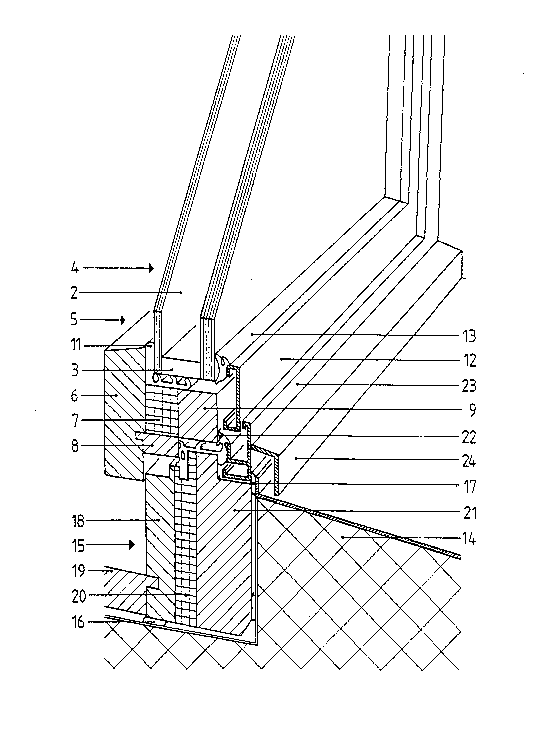Une partie des informations de ce site Web a été fournie par des sources externes. Le gouvernement du Canada n'assume aucune responsabilité concernant la précision, l'actualité ou la fiabilité des informations fournies par les sources externes. Les utilisateurs qui désirent employer cette information devraient consulter directement la source des informations. Le contenu fourni par les sources externes n'est pas assujetti aux exigences sur les langues officielles, la protection des renseignements personnels et l'accessibilité.
L'apparition de différences dans le texte et l'image des Revendications et de l'Abrégé dépend du moment auquel le document est publié. Les textes des Revendications et de l'Abrégé sont affichés :
| (12) Demande de brevet: | (11) CA 2066621 |
|---|---|
| (54) Titre français: | CADRE ISOLANT POUR FENETRES OU PANNEAUX DE PAREMENT |
| (54) Titre anglais: | STATICALLY STABLE FRAME WITH FULL THERMAL BREAK FOR WINDOWS AND CLADDING PANELS |
| Statut: | Réputée abandonnée et au-delà du délai pour le rétablissement - en attente de la réponse à l’avis de communication rejetée |
| (51) Classification internationale des brevets (CIB): |
|
|---|---|
| (72) Inventeurs : |
|
| (73) Titulaires : |
|
| (71) Demandeurs : |
|
| (74) Agent: | SMART & BIGGAR LP |
| (74) Co-agent: | |
| (45) Délivré: | |
| (86) Date de dépôt PCT: | 1991-07-22 |
| (87) Mise à la disponibilité du public: | 1992-01-21 |
| Requête d'examen: | 1998-07-20 |
| Licence disponible: | S.O. |
| Cédé au domaine public: | S.O. |
| (25) Langue des documents déposés: | Anglais |
| Traité de coopération en matière de brevets (PCT): | Oui |
|---|---|
| (86) Numéro de la demande PCT: | PCT/CH1991/000152 |
| (87) Numéro de publication internationale PCT: | CH1991000152 |
| (85) Entrée nationale: | 1992-03-20 |
| (30) Données de priorité de la demande: | ||||||
|---|---|---|---|---|---|---|
|
(57) Abstract
In order to obtain frames, in particular for windows, that without excessive
depths of construction provide insulating values approximately the same as those of the
insulating panes, a mechanically stable frame is disclosed, having a full thermal break
between inner (5) and outer frames, without any heat bridge. For that purpose, both
frames are composed of inner and outer continuous parts (6 and 9, 18 and 21) between
which is laid an insulating element (7, 20) capable of receiving and transmitting me-
chanical forces. The pane (4) to be mounted in the inner frame (5) is also thermally in-
sulated from the frame pans (6, 9, 12) by means of lip seals (11, 13). In order to seal the
gap between the inner (5) and outer (15) frames, at least one further lip seal (22) is pro-
vided.
Note : Les revendications sont présentées dans la langue officielle dans laquelle elles ont été soumises.
Note : Les descriptions sont présentées dans la langue officielle dans laquelle elles ont été soumises.

2024-08-01 : Dans le cadre de la transition vers les Brevets de nouvelle génération (BNG), la base de données sur les brevets canadiens (BDBC) contient désormais un Historique d'événement plus détaillé, qui reproduit le Journal des événements de notre nouvelle solution interne.
Veuillez noter que les événements débutant par « Inactive : » se réfèrent à des événements qui ne sont plus utilisés dans notre nouvelle solution interne.
Pour une meilleure compréhension de l'état de la demande ou brevet qui figure sur cette page, la rubrique Mise en garde , et les descriptions de Brevet , Historique d'événement , Taxes périodiques et Historique des paiements devraient être consultées.
| Description | Date |
|---|---|
| Inactive : CIB de MCD | 2006-03-11 |
| Inactive : CIB de MCD | 2006-03-11 |
| Demande non rétablie avant l'échéance | 2000-07-24 |
| Le délai pour l'annulation est expiré | 2000-07-24 |
| Réputée abandonnée - omission de répondre à un avis sur les taxes pour le maintien en état | 1999-07-22 |
| Modification reçue - modification volontaire | 1998-08-25 |
| Inactive : Acc. réc. RE - Pas de dem. doc. d'antériorité | 1998-08-11 |
| Inactive : Renseign. sur l'état - Complets dès date d'ent. journ. | 1998-08-11 |
| Inactive : Dem. traitée sur TS dès date d'ent. journal | 1998-08-11 |
| Exigences pour une requête d'examen - jugée conforme | 1998-07-20 |
| Toutes les exigences pour l'examen - jugée conforme | 1998-07-20 |
| Demande publiée (accessible au public) | 1992-01-21 |
| Date d'abandonnement | Raison | Date de rétablissement |
|---|---|---|
| 1999-07-22 |
Le dernier paiement a été reçu le 1998-07-17
Avis : Si le paiement en totalité n'a pas été reçu au plus tard à la date indiquée, une taxe supplémentaire peut être imposée, soit une des taxes suivantes :
Les taxes sur les brevets sont ajustées au 1er janvier de chaque année. Les montants ci-dessus sont les montants actuels s'ils sont reçus au plus tard le 31 décembre de l'année en cours.
Veuillez vous référer à la page web des
taxes sur les brevets
de l'OPIC pour voir tous les montants actuels des taxes.
| Type de taxes | Anniversaire | Échéance | Date payée |
|---|---|---|---|
| TM (demande, 6e anniv.) - générale | 06 | 1997-07-22 | 1997-05-26 |
| TM (demande, 7e anniv.) - générale | 07 | 1998-07-22 | 1998-07-17 |
| Requête d'examen - générale | 1998-07-20 |
Les titulaires actuels et antérieures au dossier sont affichés en ordre alphabétique.
| Titulaires actuels au dossier |
|---|
| HARING AND CO. AG |
| Titulaires antérieures au dossier |
|---|
| CHRISTOPH HARING |
| FRITZ ROTH |